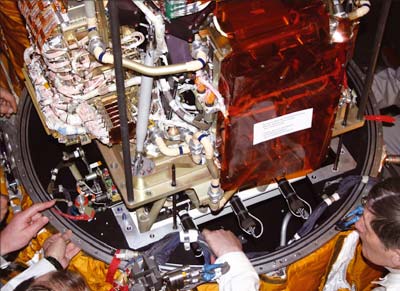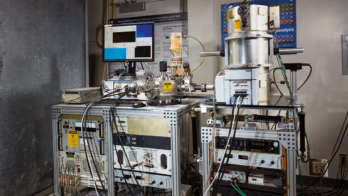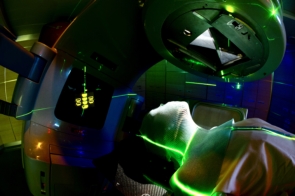
Image credit: PAMELA collaboration.
The collaboration for the Payload for Antimatter Matter Exploration and Light-nuclei Astrophysics (PAMELA) experiment has published evidence of a cosmic-positron abundance in the 1.5–100 GeV range. This high-energy excess, which they identify with statistics that are better than previous observations, could arise from nearby pulsars or dark-matter annihilation.
PAMELA, which went into space on a Russian satellite launched from the Baikonur cosmodrome in June 2006, uses a spectrometer – based on a permanent magnet coupled to a calorimeter – to determine the energy spectra of cosmic electrons, positrons, antiprotons and light nuclei. The experiment is a collaboration between several Italian institutes with additional participation from Germany, Russia and Sweden.
Preliminary, unofficial results from the PAMELA mission appeared last autumn on preprint servers together with speculation that PAMELA had found the signature of dark-matter annihilation. The paper by Oscar Adriani from the University of Florence and collaborators now published in Nature is more cautious with the dark-matter interpretation of the positron excess, identifying pulsars as plausible alternatives. The data presented include more than a thousand million triggers collected between July 2006 and February 2008. Fine tuning of the particle identification allowed the team to reject 99.9% of the protons, while selecting more than 95% of the electrons and positrons. The resulting spectrum of the positron abundance relative to the sum of electrons and positrons represents the highest statistics to date.
Below 5 GeV, the obtained spectrum is significantly lower than previously measured. This discrepancy is believed to arise from modulation of the cosmic rays induced by the strength of the solar wind, which changes periodically through the solar cycle. At higher energies the new data unambiguously confirm the rising trend of the positron fraction, which was suggested by previous measurements. This appears highly incompatible with the usual scenario in which positrons are produced by cosmic-ray nuclei interacting with atoms in the interstellar medium. The additional source of positrons dominating at the higher energies could be the signature of dark-matter decay or annihilation. In this case, PAMELA has already shown that dark matter would have a preference for leptonic final states. Adriani and colleagues deduce this from the absence of a similar excess of the antiproton-to-proton abundance, a result that they published earlier this year. They suggest that the alternative origin of the positron excess at high energies is particle acceleration in the magnetosphere of nearby pulsars producing electromagnetic cascades.
The authors state that the PAMELA results presented here are insufficient to distinguish between the two possibilities. They seem, however, confident that various positron-production scenarios will soon be testable. This will be possible once additional PAMELA results on electrons, protons and light nuclei are published in the near future, together with the extension of the positron spectrum up to 300 GeV thanks to on-going data acquisition. Complementary information will also come from the survey of the gamma-ray sky by the Fermi satellite.





